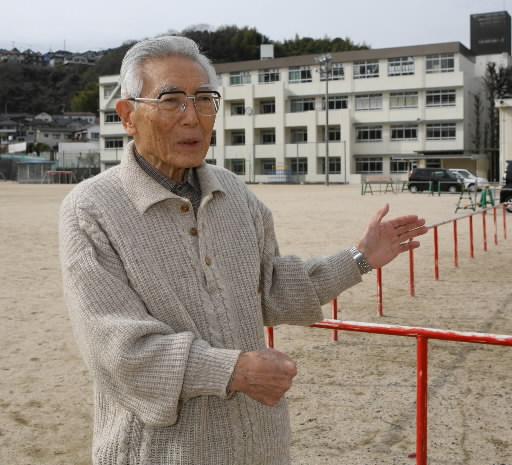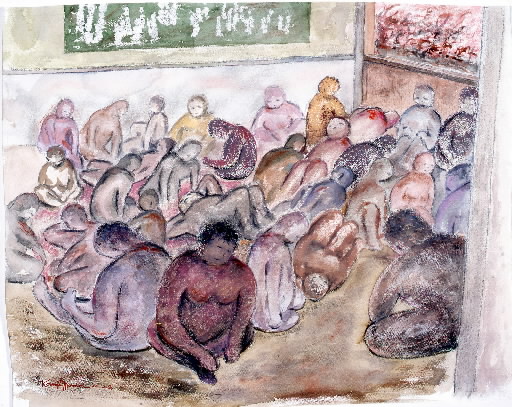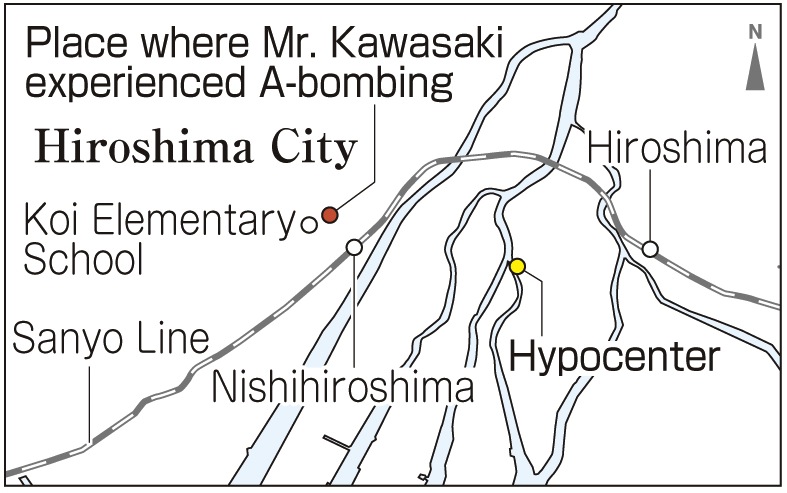Miyoji Kawasaki, 83, Nishi Ward, Hiroshima
May 28, 2013
Join hands globally for nuclear abolition
Unable to forget the sight and smell of burn victims
Miyoji Kawasaki, 83, experienced the atomic bombing while at home in Koimachi (part of present-day Nishi Ward), less than 3 kilometers from the hypocenter. On August 6, after the bomb exploded, people who had been severely wounded, or were badly burned, were evacuated from the city center to his home. Mr. Kawasaki recalls the sight of a woman whose back was burned and the smell of charred bodies. Even today, he is haunted by the memories.
Mr. Kawasaki was 16 years old when the atomic bombing took place. He had graduated from junior high school (under Japan’s old system of education) and was set to enter Hiroshima Normal School (now Hiroshima University). The school’s entrance ceremony had been delayed, however, so he was still at home, waiting. Then August 6 came. It was a hot morning and the cicadas were whirring. He was at home, having just finished tidying the house, when suddenly there was a bright flash in the sky.
The windows of the house shattered, and panels from the ceiling fell. His left arm bleeding, Mr. Kawasaki fled the house and found the world outside dark and silent. It was an eerie feeling, he recalls.
Afterward, people who were injured came to his house, seeking shelter. A few days later, he counted and found that there were a total of 29, including him and his family. Although most were relatives, some were strangers. One man’s leg bone was jutting out. A woman had been badly burned and the flesh on her back were now infested with maggots. Mr. Kawasaki helped prepare meals and went into the mountains to gather soil to cool their wounds.
He remembers that, among the 29 people, around three died. He helped carry one woman on a board to Koi National School (present-day Koi Elementary School in Nishi Ward), near his home, to cremate the body.
He saw scores of A-bomb victims at the school. Bodies were being cremated on the school yard, and the smell drifted to his house.
After the war, Mr. Kawasaki became a junior high school English teacher. He was inspired to become an English teacher after encountering friendly soldiers from the Allied Forces during Japan’s postwar occupation.
Mr. Kawasaki has actively opened his home to visitors from overseas and, since 1988, 99 people from 19 countries have stayed at his house. This includes people from Kazakhstan, which suffered repeated nuclear tests during the era of the former Soviet Union.
Along with his wife Sachiko, 78, he is a member of the “Hiroshima-Semipalatinsk Project,” a citizens’ group engaged in providing medical support to Kazakhstan. “I want people to know about all the nuclear damage in the world,” Mr. Kawasaki said with conviction, “and I want to increase the number of people seeking to abolish nuclear weapons.”
To today’s children and youth, he appeals: “If war is about to break out, take action with as many others as you can to stop it. There should never be another war.”
As a first step toward peace, Mr. Kawasaki also offered the advice, “Let’s start making a good classroom atmosphere where everyone can talk about things freely without any bullying.” (Sakiko Masuda, Staff Writer)
Koi National School: Bones from 2,000 victims are unearthed
Koi National School (now Koi Elementary School in Nishi Ward, Hiroshima) became a relief station after the A-bomb attack and took in scores of wounded. Many of them were boys and girls hit by the blast while mobilized to help create a fire lane in the city center.
A note made by an A-bomb survivor, describing conditions at the school that day, states: “There were so many victims on the floor, their bodies burned and skin peeled away, that there was no space to walk.” This scene illustrates the misery of that time.
Ditches were dug on the school yard, and a great number of bodies were cremated there. In 1949, human bones from about 2,000 victims were unearthed.
In the summer of 2010, former students of the school who experienced the atomic bombing there raised a memorial at the site. The school has held a memorial service every August, since the year 2000, with students taking part in the ceremony.
Kazuichi Nakayama, the school principal, said, “I hope children understand that nuclear weapons shouldn’t be produced or used, and that this message should be conveyed to others.”
Teenagers’ Impressions
I was shocked by the long-term nuclear damage
Mr. Kawasaki has been lending his support to people in Kazakhstan, where there was a nuclear test site. Even though the nuclear test site is now closed, people continue to suffer damage to their health. It became clear to me that nuclear weapons wreak terrible damage. Like Mr. Kawasaki, I hope that people everywhere will show interest in the radiation sufferers of the world. (Takeshi Iwata, 14)
I sensed his hope for young people
Mr. Kawasaki stressed his hope to us that young people understand the danger of nuclear power plants. When I heard that people in many parts of the world are suffering because of nuclear tests and accidents, I again realized the horror of nuclear weapons and nuclear power.
For the many people who were victims of nuclear weapons and war, I want to convey the importance of peace and cherishing human life. (Yuri Ryokai, 15)
Staff Writer’s Notebook
Mr. and Mrs. Kawasaki remain in contact with people in Kazakhstan, where nuclear tests were repeatedly performed by the former Soviet Union. They have visited Kazakhstan themselves and have welcomed Kazakh students at their home in Japan.
I was struck by some personal impressions written by Sachiko Kawasaki during her third visit to Kazakhstan in 1999. After seeing the terrible damage caused by the more than 450 nuclear tests, Sachiko wrote: “Can we forgive ourselves for the enormous gap among the different people of the earth when it comes to the idea of human dignity? We must pledge to create a world without nuclear tragedies for children everywhere.”
More than 20 years have passed since the nuclear test site in Kazakhstan was closed. Today, however, there are still many people who suffer from cancer and cardiac disease, among the estimated 1.5 million people whose health was harmed by the nuclear tests.
When we interviewed Mr. Kawasaki, he talked about the Chernobyl disaster that occurred in the former Soviet Union and the nuclear tests that took place in the Pacific Islands. He stressed the fact that “It’s important to look at the other damage in the world that has been done by nuclear weapons and nuclear power.”
Following the accident at the Fukushima No. 1 (Daiichi) nuclear power plant, nuclear issues are again a concern. Mr. Kawasaki offered important words for young people, saying, “All things nuclear have a significant impact on human beings, not just nuclear weapons. When an accident occurs at a nuclear power plant, it can cause suffering for many people for a long time. We should keep that in mind as well.” (Sakiko Masuda)
(Originally published on February 25, 2013)
Unable to forget the sight and smell of burn victims
Miyoji Kawasaki, 83, experienced the atomic bombing while at home in Koimachi (part of present-day Nishi Ward), less than 3 kilometers from the hypocenter. On August 6, after the bomb exploded, people who had been severely wounded, or were badly burned, were evacuated from the city center to his home. Mr. Kawasaki recalls the sight of a woman whose back was burned and the smell of charred bodies. Even today, he is haunted by the memories.
Mr. Kawasaki was 16 years old when the atomic bombing took place. He had graduated from junior high school (under Japan’s old system of education) and was set to enter Hiroshima Normal School (now Hiroshima University). The school’s entrance ceremony had been delayed, however, so he was still at home, waiting. Then August 6 came. It was a hot morning and the cicadas were whirring. He was at home, having just finished tidying the house, when suddenly there was a bright flash in the sky.
The windows of the house shattered, and panels from the ceiling fell. His left arm bleeding, Mr. Kawasaki fled the house and found the world outside dark and silent. It was an eerie feeling, he recalls.
Afterward, people who were injured came to his house, seeking shelter. A few days later, he counted and found that there were a total of 29, including him and his family. Although most were relatives, some were strangers. One man’s leg bone was jutting out. A woman had been badly burned and the flesh on her back were now infested with maggots. Mr. Kawasaki helped prepare meals and went into the mountains to gather soil to cool their wounds.
He remembers that, among the 29 people, around three died. He helped carry one woman on a board to Koi National School (present-day Koi Elementary School in Nishi Ward), near his home, to cremate the body.
He saw scores of A-bomb victims at the school. Bodies were being cremated on the school yard, and the smell drifted to his house.
After the war, Mr. Kawasaki became a junior high school English teacher. He was inspired to become an English teacher after encountering friendly soldiers from the Allied Forces during Japan’s postwar occupation.
Mr. Kawasaki has actively opened his home to visitors from overseas and, since 1988, 99 people from 19 countries have stayed at his house. This includes people from Kazakhstan, which suffered repeated nuclear tests during the era of the former Soviet Union.
Along with his wife Sachiko, 78, he is a member of the “Hiroshima-Semipalatinsk Project,” a citizens’ group engaged in providing medical support to Kazakhstan. “I want people to know about all the nuclear damage in the world,” Mr. Kawasaki said with conviction, “and I want to increase the number of people seeking to abolish nuclear weapons.”
To today’s children and youth, he appeals: “If war is about to break out, take action with as many others as you can to stop it. There should never be another war.”
As a first step toward peace, Mr. Kawasaki also offered the advice, “Let’s start making a good classroom atmosphere where everyone can talk about things freely without any bullying.” (Sakiko Masuda, Staff Writer)
Hiroshima Insight
Koi National School: Bones from 2,000 victims are unearthed
Koi National School (now Koi Elementary School in Nishi Ward, Hiroshima) became a relief station after the A-bomb attack and took in scores of wounded. Many of them were boys and girls hit by the blast while mobilized to help create a fire lane in the city center.
A note made by an A-bomb survivor, describing conditions at the school that day, states: “There were so many victims on the floor, their bodies burned and skin peeled away, that there was no space to walk.” This scene illustrates the misery of that time.
Ditches were dug on the school yard, and a great number of bodies were cremated there. In 1949, human bones from about 2,000 victims were unearthed.
In the summer of 2010, former students of the school who experienced the atomic bombing there raised a memorial at the site. The school has held a memorial service every August, since the year 2000, with students taking part in the ceremony.
Kazuichi Nakayama, the school principal, said, “I hope children understand that nuclear weapons shouldn’t be produced or used, and that this message should be conveyed to others.”
Teenagers’ Impressions
I was shocked by the long-term nuclear damage
Mr. Kawasaki has been lending his support to people in Kazakhstan, where there was a nuclear test site. Even though the nuclear test site is now closed, people continue to suffer damage to their health. It became clear to me that nuclear weapons wreak terrible damage. Like Mr. Kawasaki, I hope that people everywhere will show interest in the radiation sufferers of the world. (Takeshi Iwata, 14)
I sensed his hope for young people
Mr. Kawasaki stressed his hope to us that young people understand the danger of nuclear power plants. When I heard that people in many parts of the world are suffering because of nuclear tests and accidents, I again realized the horror of nuclear weapons and nuclear power.
For the many people who were victims of nuclear weapons and war, I want to convey the importance of peace and cherishing human life. (Yuri Ryokai, 15)
Staff Writer’s Notebook
Mr. and Mrs. Kawasaki remain in contact with people in Kazakhstan, where nuclear tests were repeatedly performed by the former Soviet Union. They have visited Kazakhstan themselves and have welcomed Kazakh students at their home in Japan.
I was struck by some personal impressions written by Sachiko Kawasaki during her third visit to Kazakhstan in 1999. After seeing the terrible damage caused by the more than 450 nuclear tests, Sachiko wrote: “Can we forgive ourselves for the enormous gap among the different people of the earth when it comes to the idea of human dignity? We must pledge to create a world without nuclear tragedies for children everywhere.”
More than 20 years have passed since the nuclear test site in Kazakhstan was closed. Today, however, there are still many people who suffer from cancer and cardiac disease, among the estimated 1.5 million people whose health was harmed by the nuclear tests.
When we interviewed Mr. Kawasaki, he talked about the Chernobyl disaster that occurred in the former Soviet Union and the nuclear tests that took place in the Pacific Islands. He stressed the fact that “It’s important to look at the other damage in the world that has been done by nuclear weapons and nuclear power.”
Following the accident at the Fukushima No. 1 (Daiichi) nuclear power plant, nuclear issues are again a concern. Mr. Kawasaki offered important words for young people, saying, “All things nuclear have a significant impact on human beings, not just nuclear weapons. When an accident occurs at a nuclear power plant, it can cause suffering for many people for a long time. We should keep that in mind as well.” (Sakiko Masuda)
(Originally published on February 25, 2013)










